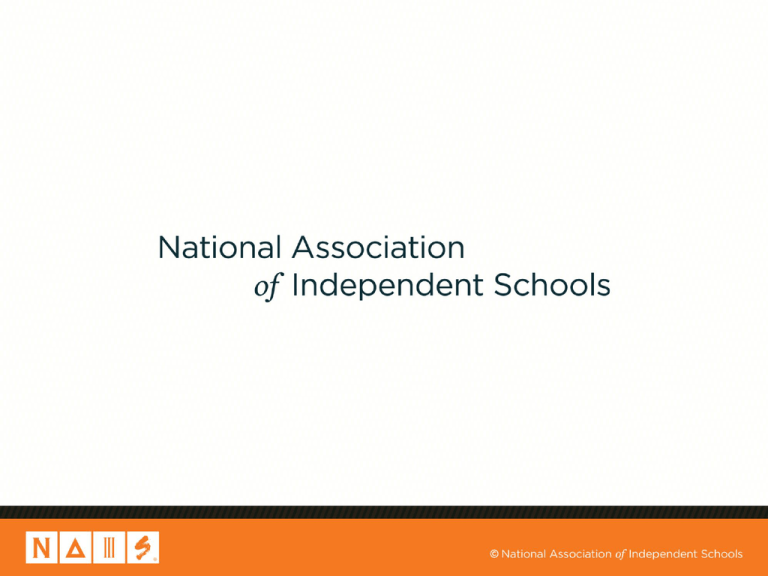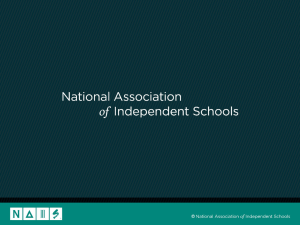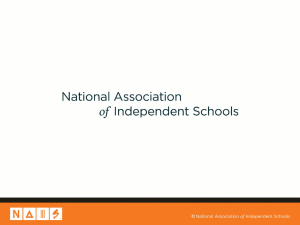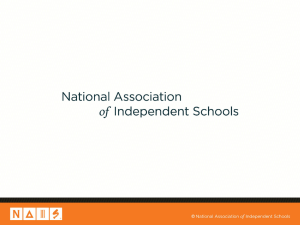25 Factors Great Schools 061213
advertisement

25 Factors Great Schools Have in Common Patrick F. Bassett, President bassett@nais.org Bassett’s 25 Indicators of Great Schools Great schools… 1. Create and perpetuate an intentional culture shaped by the adults, rooted in universal values of honesty and caring, and relentlessly oriented toward achievement. • Manifesting mission: Laurel School: “To inspire each girl to fulfill her promise and to better the world.” (“Purpose helps a girl to understand she is not the only star in the firmament, nor is she a tumbleweed being blown through life.” • Your NAIS Parent Market Segmentation Study? • Leadership/governance culture?) Bassett’s 25 Indicators of Great Schools Great schools… 2. Eclectically capitalize on the best ideas about what works in schools, those gleaned from the past as well as those deemed best for the future. (Are you a 21st C. school “in the news”?) Bassett’s 25 Indicators of Great Schools 3. Manifest a coherent philosophy of learning for students, be it constructivist, Reggio Emilia, Waldorf, Montessori, strengthsbased, progressive, traditional, 1:1, IB, or whatever — so long as it remains open to ongoing discussion, assumption testing, and constant refinement. (What’s your “differentiator”?) Bassett’s 25 Indicators of Great Schools 4. Make a substantial commitment to professional development for faculty, expecting teachers to grow as learners themselves and to develop mastery in the art and science of teaching. (Seriously invested in professional development?) Bassett’s 25 Indicators of Great Schools 5. Develop collegial means to professionalize the profession, such as rounds, lesson study, digital faculty portfolios, and the like, adopting professional development strategies that are prevalent in high-performing schools and countries around the world. (faculty portfolios of their flipped class videos & their students’ exhibitions) Bassett’s 25 Indicators of Great Schools 6. Adopt a big vision, one that continually refreshes itself in order to sustain the enterprise along the five most strategic continua: demographic, environmental, global, financial, and programmatic. (What’s your vision statement? The “postcard of your destination?”) Bassett’s 25 Indicators of Great Schools 7. Define the school’s “playground” in expansive ways, beyond the school’s borders into the local community, the region, and the world. (Your experiential ed track?) Bassett’s 25 Indicators of Great Schools 8. Demonstrate the public purpose of private education locally, nationally, and globally through a variety of means, including modeling experimentation to improve schooling and partnering with the public sector at the school and university levels. (Do you participate in Horizons/Prep for Prep programming? Joining the NNSP?) Bassett’s 25 Indicators of Great Schools 9. Embrace stewardship of the school and its resources, renewing and growing the school’s physical, financial, and human resources to achieve financial equilibrium. (Does your physical, intellectual, social, & financial capital all grow every year?) Bassett’s 25 Indicators of Great Schools 10. Enable constituents to donate their time and treasure consistently by providing the metrics on school volunteerism, financing, and eleemosynary benchmarks, and by telling the school’s story in powerfully moving ways. (Do you benchmark using NAIS StatsOnline data?) Bassett’s 25 Indicators of Great Schools 11. Pay it forward by building endowment and thereby sustaining intergenerational equity so that the next generation of families will be at least as well served by this generation as the current generation of families has been by its predecessors. (Adopt a “giving” financial discipline and culture?) Bassett’s 25 Indicators of Great Schools 12. Commit to diversity of all kinds and at all levels to create the conditions and school culture so that students learn how to appreciate & map differences, then navigate & ride the waves of change. (Diverse teams at the faculty, management, and board levels: Scott Page’s Diversity & Complexity; Cosmopolitanism & Culture GPS; Research on value of introverts & neurotics on one’s team) Bassett’s 25 Indicators of Great Schools 13. Redefine the ideal classroom setting as one of intimate environment, not small classes, since the former can occur in schools or classes of any size and even online, and the latter can miss the point of intimacy. (Know that the students:staff ratio has room to grow?) Bassett’s 25 Indicators of Great Schools 14. Create a financially sustainable future by means other than persistently large annual tuition increases, recognizing that being the best value, rather than the highest price in town, offers the strongest value proposition. (Refine the value proposition of your school?) Bassett’s 25 Indicators of Great Schools 15. Achieve extraordinary parent and alumni participation in annual giving, reflecting superb volunteer organization and execution and a grateful constituent base. (Organize to seek 100% trustee & parent participation) Bassett’s 25 Indicators of Great Schools 16. Adopt and fund “3 Rs” talent strategies that position the school to recruit, retain, and reward the best and brightest teachers, school leaders, and board members. (Seek Teach for America candidates?) Bassett’s 25 Indicators of Great Schools 17. Compensate staff members fairly and competitively related to performance and contributions to the well-being of the school and in acknowledgment of the staff’s tremendous responsibility for and impact on students. (Reward attitude and performance?) Bassett’s 25 Indicators of Great Schools 18. Provide leadership paths for teachers wishing to stay in teaching, rather than jump to administration, by creating a host of academic and task- force leadership roles. (Offer career & leadership track for teachers?) Bassett’s 25 Indicators of Great Schools 19. Track student outcomes over time, beyond the years in one’s own school, seeking data on how well the school prepared its students for the next legs of their life journeys — be it the next levels of education or life beyond. (Employ the NAIS Young Alumni Survey?) Bassett’s 25 Indicators of Great Schools 20. Seek data to make data-rich (not opinion-rich) decisions, embracing former Education Secretary Margaret Spellings’s observation, “In God we trust; all others, bring data.” (Employ the NAIS Trustee Dashboards?) Bassett’s 25 Indicators of Great Schools 21. To avoid unnecessary distractions, educate the board and parents thoroughly about “how schools work,” and about what student and parent needs a school can and cannot meet. (Deploy the prophylactic of parent and board education?) Bassett’s 25 Indicators of Great Schools 22. Market their schools with “sticky messages” that tell a compelling story. (Know your market segmentation? Your school’s best stories? Email from “marriedbutlonely”? Marketing inputs or outcomes?) Bassett’s 25 Indicators of Great Schools 23. Know their priorities when making difficult decisions, ranking first “what’s best for the school,” then “what’s best for the student,” then “what’s best for all other interests.” (Use the Institute for Global Ethics 4-way test: gut, legal, front page, role-model?) Bassett’s 25 Indicators of Great Schools 24. Know that mission-match with a prospective student (on the intake) and matriculating students (on the outtake) is the controlling factor in admissions and secondary school or college placement. (Define the sweet spot of the ability range you serve?) Bassett’s 25 Indicators of Great Schools 25. Find the right balance for the drivers of financial aid to achieve school goals of diversifying the school, managing enrollment, and attracting a talented class of students. (Know your financial aid “Sophie’s Choice” profile?) Bassett’s 25 Indicators of Great Schools All schools have the capacity to become great schools. All they need is the focus and leadership to create the proper conditions for the board, school leadership team, staff, and constituents to do so. (Choose to be, in Jim Collins’ words, “Great by Choice”: Roald Amundsen vs. Robert Falcon Scott, in their efforts to lead their teams to be the first to the South Pole in October 1911: adopt the discipline of “the 20 – mile march”; empirical creativity vs. intuition; first “shoot bullets, not missiles”) The End! Creativity, Robotics, Teaming and STEM …and wearable, functional art Grant Wood’s Victorian Survival Smithsonian Podcast interpretation by Katy Waldman, Holton Arms School Demonstration of Learning Return Return Trend #5: Market Segmentation as the New Marketing Imperative Return Return Return Return Cf. Audubon Society; National Geographic; Cheasepeak Bay Water Quality Foundation; New Knowledge Organization , etc.








